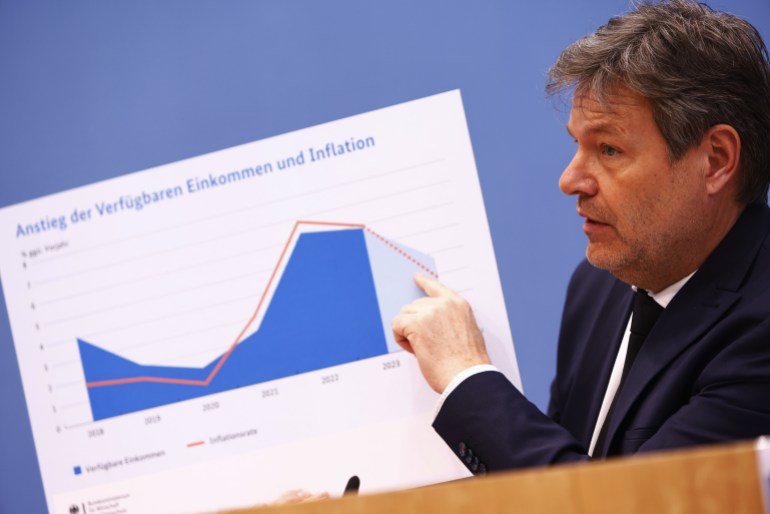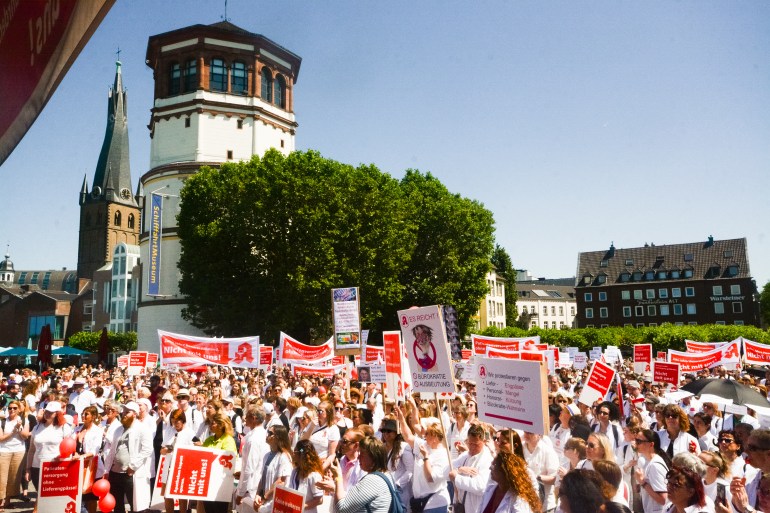Germany, Europe’s industrial powerhouse, is struggling with a critical labour shortage. By some estimates, two million jobs across the economy are vacant, and half of the country’s companies are unable to find enough workers.
Faced with this crisis, dozens of firms are testing a strategy that, on the surface, at least, might appear counterintuitive: getting workers to work fewer days.
In early February, 31 companies in Germany began a “four-day” work week pilot. The initiative is being led by not-for-profit company, 4 Day Week Global (4DWG), and management consultancy, Intraprenör. Another 14 companies are joining the initiative in March.
The German public research university, University of Münster, will carry out a scientific evaluation of the six-month-long trials, in which up to 600 employees are expected to participate.
The 4DWG, which has been conducting similar trials in many other countries, believes that reducing work days, while keeping pay at the same levels, would result in productivity gains for companies and improved wellbeing of employees, motivating a stretched workforce. The approach could also attract people to the workforce who can’t work five days a week, helping ease the labour crunch.
But how is the German experiment different from a series of efforts in other countries to test a shorter work-week? What have those previous trials shown – are workers more productive when they work fewer hours? Is it possible for the global economy to shift to a four-day work week, and will other countries follow the lead? Al Jazeera spoke to economists, experts and researchers involved in the study to find out.
The short answer: The German test uses more sophisticated techniques to compare more robust data than earlier trials in other countries, say economists, experts and researchers, though it still has shortcomings. Its results could offer the clearest picture yet of the gains and pitfalls of a four-day week. But even the staunchest advocates for the strategy concede that moving all jobs to a shorter work week may not be possible.

The long history of the short work week debate
The demand for a work-life balance emerged from the trade union movement in parts of the world in the 19th century that campaigned for eight hours of work, eight hours of recreation and eight hours of rest.
Then, the modern economy saw its first full test of a shorter work week. Timothy T Campbell, a senior lecturer in corporate social responsibility and business ethics at the United Kingdom-based De Montfort University, traced the origins of a reduced work week to the 1940s when drivers of fuel and gasoline delivery trucks in the United States worked four days a week.
In the decades that followed, especially since the 1960s, several four-day week experiments were conducted, Campbell concluded in a research paper.
“But it was in the early 1970s that interest in the 4DWW (four-day work week) exploded, almost exclusively in the US, in both the popular press and academia,” the study found. “It did not last. By the end of the 1970s very little interest remained.”
Back then, the most popular way of trying out a four-day work week, which was tested in diverse sectors of the economy, including manufacturing, was to work 10 hours a day for four days a week.
“While there were reported advantages such as improved morale, job satisfaction, decreased absenteeism and so on, there was also evidence of increased monitoring by employers and intensified work (due to prolonged daily hours), which could lead to more stress rather than less,” Campbell told Al Jazeera.
Today, the mean weekly hours that a person around the globe works for stands at 44 hours, according to the International Labour Organization’s World Employment and Social Outlook report published in January. Different countries have their own laws capping maximum daily work, beyond which workers are entitled to overtime pay.
An earlier ILO report noted that the average hours of work per week was the highest in South Asia (49 hours), followed by Eastern Asia (48.8 hours) and the lowest in North America (36 hours) and Northern, Southern and Western Europe (37.2 hours).
Around the world, one in three people worked what are considered to be long working hours – 48 hours a week – before the COVID-19 pandemic. In some countries like India, a majority of workers clocked long hours. Only one-fifth of employees around the globe worked less than 35 hours a week.

‘A paradox’
The underlying assumption of the reduced working hours trial, said Julia Backmann, professor and chair for a team looking at the transformation of work at the University of Münster, is that with fewer working hours, workers will have more time to recover from work.
This, according to the hypothesis of the experts who have designed the experiment, could help workers focus more when they go back to their jobs. Backmann is on 4DWG’s research team and is involved with the German trials.
Trial advocates said that one of the main goals is addressing the labour shortage in the German economy by attracting workers towards companies with better work-life balance. They said that it would benefit companies, especially in sectors such as healthcare and education, where the pay is comparatively less attractive, or industries such as law or information technology, where the competition for attracting workers is high.
“It’s kind of a paradox. If you ask politicians, when it comes to labour shortage, they would say ‘everyone has to work more hours and not less’,” Carsten Meier, co-founder and partner at Intraprenör, the Berlin-based consultancy involved in the trials, told Al Jazeera in an interview, “A four-day work week is an attractive concept to solve labour shortage as it makes it easier for companies to gain more attraction with the right talent. That’s the main objective of the participating companies.”
German economy minister Robert Habeck recently said that the biggest hurdle in the way of the country’s economic growth would be the labour shortage. He put the estimated figure of job vacancies at two million, even as the estimated skilled workers stage is expected to go up to five million by 2035 in Germany.
Meier said that the four-day work week is expected to have positive effects on both the mental and physical wellbeing of employees, which will reduce sick leave, as it will leave more room for leisure and physical activities. “For instance, men would be more present towards caretaking activities towards their children or elderly people, helping women to get into more types of full-time work, which will also address the labour shortage,” he said.
Germany lost about 26 billion euros ($28.5bn) of economic value in 2023 due to high levels of sick leave – among the highest in developed countries, according to vfa, the country’s research-based association of pharmaceutical companies.
UK-based research group Autonomy and the 4DWG found encouraging results in the “world’s largest” six-month trials that took place in the United Kingdom in 2022, with 2,900 workers participating from 61 companies. The trials saw a 65 per cent reduction in absenteeism, due to illness and personal leave, and reduced levels of stress and burnout, while there was no effect on company revenues. However, the trials also saw employees reporting higher work intensity. One year on, nine out of 10 companies are continuing with a four-day work week, while half of the firms have made the four-day work week permanent.

Designing a four-day work week
The German trials have been designed flexibly keeping in mind the differing needs of various sectors.
“Our principle is based on a 100-80-100 rule, a productivity-focussed meaningful reduction in work time, which means 100 percent pay for 80 percent time and 100 percent productivity,” Charlotte Lockhart, managing director and founder of 4DWG told Al Jazeera. “Different businesses will have different ways of doing that.”
Yet, the German experiment is more complex than a simple exercise in shrinking working hours.
Most companies participating in the German experiment – while reducing weekly work hours from 40 – have not gone down to 32, a number that would fit a four-day work week, with eight hours a day.
“What’s required is that they reduce their working time significantly at least 10 percent (of their current weekly work time) and that the pay remains the same so there is no pay cut,” said Backmann.
Many companies, Backmann said, felt that reducing work hours further would be “too much” to start with.
Since the participation of companies is voluntary, and the terms of the trials are flexible, some firms are giving employees a day off during the week. However, by doing so, each worker may be working extra hours on their remaining working days to get three days scheduled off from work.
The 4DWG team has been involved in conducting similar studies in other countries to test the “four-day” work week, including New Zealand, the United Kingdom, the United States, Ireland and Australia. Compressed work hour experiments have been previously conducted in Sweden, Finland, Iceland and Portugal, even as labour unions have, in recent years, been demanding reduced work hours.
“This is done by effectively eliminating some of the unproductive activity that occurs in the workplace on a daily basis,” Andrew Barnes, co-founder of 4DWG told Al Jazeera. “It could be meetings, processes, attitudes, interruptions or people spending too much time on the internet, etc. There’s all sorts of things when you give people more time, then they have time to deal with those things outside the work environment.”
Lockhart said that 90 percent of the firms that have participated in their global trials so far have stayed on “some form of reduced work hour week” after the experiments. The studies conducted by 4DWG have shown a “25 per cent” increase in productivity for firms, she said.
However, independent researchers, who have looked into the findings and the methodologies of the trials conducted by 4DWG and other similar pilots conducted in New Zealand and Iceland, have found many flaws, including with sample size, issues with data collection and limited transparency in reporting the trial outcomes.

Design flaws
“There are definitely significant empirical limitations in the four-day week pilots carried out by organisations that have a clear intention to show positive results that most journalists are not taking into consideration,” Hugo Cuello, senior policy analyst at Madrid-based Innovation Growth Lab, told Al Jazeera in an email.
Cuello, who wrote a research paper, Assessing the Validity of Four-day Week Pilots last year, found key problems. In such experiments, companies decide to take part in the trial voluntarily and are not chosen on a randomised basis, which makes the study non-representative across the economy.
Cuello noted that the trials also overrelied on self-reported data from employees asking them questions about their wellbeing or productivity before, midway and after the experiment.
The problem of relying too much on self-reporting is that it could lead to a phenomenon known as the Hawthorne effect. This basically means that employees, being aware that they are under observation during the short-term trials, may report positive effects with the hope that it could lead to permanency in work hour reductions.
There are challenges, too, that research into earlier four-day work week trials has thrown up.
As the compressed work week may lead to longer working hours in a day, despite a day off, some researchers have reported fatigue and stress among employees, even as others found evidence of reduced stress.
Cuello’s research also showed how the four-day work trials tried to establish a correlation between reduced working hours and increased productivity or wellbeing of employees over the trial period without considering other factors that could be at play.
As part of the trials, the advocacy groups collected data on key performance indicators from companies and compared it with a period a year earlier. However, they did not necessarily factor in other external factors that might have been at play, affecting productivity before the trial period began, such as weather extremities or the COVID-19 pandemic.

Overcoming obstacles
That’s where the German trials could be different.
The experiment is attempting to overcome some of the limitations observed in the previous trials by collecting “more objective data”, looking beyond the self-reported data, Backmann said.
The researchers will collect hair samples of employees to determine the level of cortisol in their body before, during and after the trial period – which will in turn be used to measure stress levels and how and if they change.
About 200 workers will also wear fitness trackers throughout the trial period, which will be used to measure other health parameters such as heart rate, sleeping patterns and activity levels. However, the Hawthorne effect cannot be completely ruled out even in this case as employees who are aware they are being monitored might, for instance, engage in increased physical activity, Backmann admitted. Since the trials also began in winter and would end in summer, seasonal change could also affect the mental health of workers, she said.
However, to control for social desirability effects – in simpler words, to ensure employees do not report being less stressed as part of the trial expectations – the researchers would also collect information from a control group of organisations which will not reduce working hours. Employees in those organisations would also wear fitness trackers and complete short surveys.
The survey will track employee personality traits over the six-month trial period to check whether they reported a significant behaviour change. “This would give us an indication whether the response of employees to the survey are completely truthful as there shouldn’t ideally be a big change in their personality reported over six months,” Backmann said.
Already, some limitations are clear, though.
Lonnie Golden, professor of economics and labour at Penn State University, said that retail, manufacturing and construction sectors, where typically hours of workers are longer, have found it hard to switch to a four-day work week. There was more acceptance in other sectors, Golden, an advisory council member at WorkFour, a non-profit set up in partnership with 4DWG, told Al Jazeera.
For now, the German trial researchers hope to report back objective results later this year. And if the news is grim, they’ll still be upfront about it, said Backmann. “I’m not of the opinion that every organisation should now switch to a four-hour work week,” Backmann said. “If we see critical aspects or negative effects, I’m happy to also share them.”







